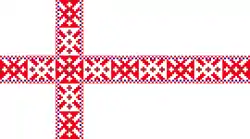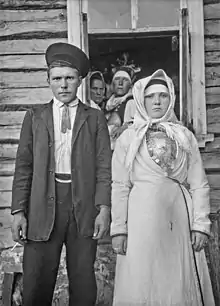Setos
Setos (Seto: setokõsõq, setoq, Estonian: setukesed, setud) are an indigenous Finno-Ugric ethnic and linguistic minority in south-eastern Estonia and north-western Russia. Setos are mostly Seto-speaking Orthodox Christians of Estonian nationality. The Seto language (like Estonian and Finnish) belongs to the Finnic group of the Uralic languages. The Setos seek greater recognition, rather than having their language considered a dialect of Estonian. Along with Orthodox Christianity, vernacular traditional folk religion is widely practiced and supported by Setos.
 Flag of Setos | |
| Regions with significant populations | |
|---|---|
| 15,000 | |
| 300 (2013)[1] | |
| Languages | |
| Seto, Estonian, Russian | |
| Religion | |
| Eastern Orthodox, Native Faith | |
| Related ethnic groups | |
| other Baltic Finns | |
There are approximately 15,000 Setos around the world. The bulk of Setos, however, are found in the Setomaa region, which is divided between south-eastern Estonia (Põlva and Võro counties) and the north-western Russian Federation (Pechorsky District of Pskov Oblast). Setos are an officially protected ethnic minority of Pskov Oblast.
The culture of Setos blossomed in the early 20th century when many national societies of Setos were organized. In 1905 the number of Setos reached its peak. After the proclamation of independence of Estonia its authorities adopted a policy of Estonification of its population, which eventually led to virtual disappearance of Setos as a distinctive linguistic entity of Estonia. In Russia, due to the influence of Estonian language schools, high rates of mixed marriages, and emigration to Estonia, the number of Setos drastically decreased as well.
Ethnic history


Before A.D. 600 the whole of Setomaa was within the vast northern Finnic lands of the indigenous Finno-Ugric peoples. The first significant event that separated Setos from Estonians was forced conversion of the latter into Catholicism in the 13th century, while Setos who lived in Novgorod Land remained pagans. In the 15th century Setos were converted into Orthodox Christianity but kept their vernacular beliefs. Later elements of Catholic culture were brought to the Setos by Estonian colonists, while in Estonia itself they nearly disappeared after the Lutheran reformation in Estonia.
The border issue
In 1920, with the peace treaty of Tartu, the area Setomaa (Setoland) was ceded to the newly created Republic of Estonia and it was included into Petseri County. As a result of World War II, the Republic of Estonia was forcibly annexed to the Soviet Union. And on August 15, 1944 the border between the Estonian Soviet Socialist Republic and the Russian Soviet Federated Socialist Republic was revised by Moscow authorities to what it is now. The issue became topical as the Republic of Estonia was restored in the borders of the Estonian Soviet Socialist Republic in 1991 and a national border was established soon afterwards. The establishment of the border brought about the division of Setomaa between two countries for the first time in history.
_-_025.jpg.webp)
Seto leelo
In 2009, the Setos' polyphonic style of folk singing, called leelo, was added to the UNESCO list of intangible cultural heritage.[2] Seto leelo is usually performed by women,[2] dressed in traditional clothing.[3] During the Seto Kingdom Day celebration, the winning lead singer of a leelo group is awarded the title of "Mother of Song".[2]
Representative organisations
The Seto Congress, a body comprising representatives of Seto villages and organisations, is regularly convened every three years and elects a permanent Council of Elders.
The Society for Seto Congress was a member of the European Bureau for Lesser-Used Languages. The Setomaa federation of municipalities in Estonia (Setomaa Valdade Liit, comprising the communes of Mikitämäe, Värska, Meremäe and Misso) publishes the newspaper Setomaa, partly in the Seto language, partly in Estonian.
Also, every year the Seto choose a steward of King Peko (sootska or ülebtsootska) for the so-called Kingdom of Setomaa at the annual celebration of the Day of the Kingdom (Seto Kuningriigi päiv), a local festival that rotates among the bigger Seto villages.[4] The office is largely ceremonial and has been held by local activists, politicians, entrepreneurs and scholars. The tradition was initiated by Paul Hagu, an ethnic Seto and a researcher of Seto folk songs and traditional vocal polyphony (Leelo) at the University of Tartu.
See also
External links
- Photo essay by BBC News - "In pictures: The Seto people, a border people"
- "Seto Culture in Setumaa" on visitestonia.com
- Picture Stories on National Geographic - A Fairytale Kingdom Faces Real-Life Troubles by Jérémie Jung and Eve Conant
References
- "Seto Leelo, Seto polyphonic singing tradition". UNESCO. Retrieved 3 November 2012.
- Kevin O'Connor (2006). Culture And Customs of the Baltic States. Greenwood Publishing Group. p. 178. ISBN 978-0-313-33125-1. Retrieved 5 November 2012.
- BBC News, In Pictures: The Seto People
- Eichenbaum, K.; Pajusalu, K. (2001): Setode ja võrokeste keelehoiakutest ja identiteedist. - Keel ja Kirjandus nr 7, lk. 483-489.
- Eller, K. (1999): Võro-Seto language. Võro Instituut'. Võro.

